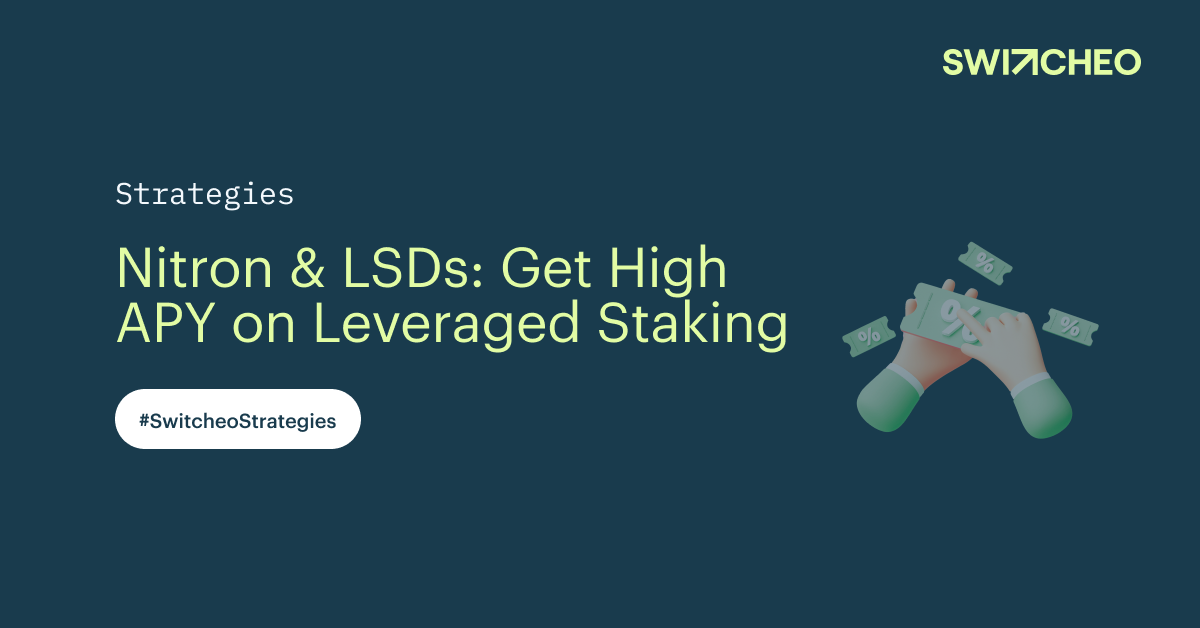LSDs? The drug?
No, LSDs stands for Liquid Staked Derivatives, and it is a new way to have more fun partying in Cosmos DeFi.
With the launch of Nitron, Carbon's money market on Demex and our partnership with various liquid staking providers and integration with their LSD tokens, users can get higher staking APY with leveraged staking.
Read on to find out how this leveraged staking strategy works.
Why are LSDs cool?
We wrote an article about Why Liquid Staking will Change Cosmos Forever but here's a quick summary.
As proof-of-stake became popular, users had to choose between:
- Staking and locking up their tokens to get passive staking rewards and securing the network, but miss out on high yield through DeFi
- Using the tokens for active DeFi activities to earn a higher yield, but miss out on passive staking rewards and not helping to secure the network
Liquid staking introduced a mechanism that takes a Proof-of-Stake token and stake that token via a smart contract which mints a receipt token also known as an LSD as it derives value from the underlying staked asset.
With LSDs and liquid staking, users can:
- Be more capital efficient as users can use their staked assets for liquidity, helping cosmos ecosystem be more robust with more liquidity
- Have better user experience as it is easy to deposit PoS tokens for higher APR, or redeem if they need more liquidity for the native PoS token
- Continue to secure the network while enjoying DeFi activities
As an example, liquid staking was popularized by Lido protocol on Ethereum with their creation of stETH, which is backed by staked Ethereum, a proof-of-stake token, earning around 5% a year.
This stETH token can then be used in DeFi for lending, borrowing, liquidity provision and more, allowing users to earn DeFi yield on top of staking rewards.
Therefore, LSDs helped to solve this dilemma, allowing users to earn both staking rewards and DeFi yield with their holdings, unlocking billions of value in staked ATOM to flow into Cosmos DeFi Dapps.
To know more about liquid staking, here’s a video by Cosmos.
What is Leveraged Staking?
Leveraging staking, as its name suggests, allows you to achieve higher staking APR through leverage.
Here is how it works using liquid staked ATOM (lsATOM) as an example:
- Bridge lsATOM to Carbon chain which is both an EVM and IBC chain.
- Deposit your lsATOM on the Nitron money market and enable as collateral.
- Delta neutral version: Borrow ATOM token and bridge it to an LSP and stake to get lsATOM.
- Leverage long alternative (degen): The user can borrow other assets or mint USC to swap into lsATOM, they may also do this if there is insufficient ATOM to borrow. Doing this results in a liquidation price but will likely have a much higher APR too.
- Loop steps 2 and 3 or 4 until satisfied.
With each loop, a user increases the total amount of LSD that they hold, and thus their APR is higher. This effectively multiplies the staking rewards.
Delta neutral explanation:
For the delta neutral approach, the user is essentially short ATOM and long lsATOM, on leverage, and lsATOM should go up overtime gradually against ATOM due to its value accruing mechanism, hence leveraging makes sense as it's a basis trade.
However, the user will have to pay borrow fees for borrowing the native asset. The borrow APY is expected to be significant due to the nearly risk-free nature of delta neutral. This is because lsATOM should not depeg too much against ATOM, hence the borrower's loan (ATOM) to collateral value (lsATOM) should remain healthy regardless of ATOM's price. As long as the staking APY is higher than the borrow APY, leverage looping will generally be profitable.
Leverage long explanation:
For the leverage long approach, it is a strategy for users that wants exposure to the USD price of lsATOM as they believe that lsATOM will go up overtime against USD.
This is far more dangerous as there will be a liquidation risk and lsATOM can go down as well, liquidating the user. To mitigate cascading liquidations, Nitron has a public liquidation platform to allow for anyone to participate in liquidations for a bonus, creating a smoother deleveraging.
However, the staking APY is likely much higher as well as the user is not borrowing native ATOM which is expected costly, and is instead borrowing assets with a lower borrow APR, or is minting USC, and then swapping those assets into lsATOM.
Calculating APY of delta-neutral leveraged staking
There are a few variables to factor in the APY for leverage staking:
- Liquid staking APR (often lesser than the actual staking APR and is dependent on the LSP)
- Borrow APR (how much it cost to borrow the non-staked token)
- Incentives APR (some LSPs may provide additional incentives to their LSD to attract more users to their LSD and gain market share)
- Price of LSD (to calculate the value)
- Max LTV (loan to value, determines how leverage affects your APY)
- Starting value (how much value in LSD you are starting with)
I've created a handy APY calculator for both delta neutral positions and leverage long positions which includes how much the LSD needs to drop in dollar value before liquidation occurs. Disclaimer: Use at your own risk.
Risks of leveraging staking and LSDs
Recently there was an exploit on ANKR protocol on BSC. An admin key of ANKR was compromised and an infinite amount of aBNBc (an LSD) was minted and dumped onto a DEX for BNB.
The exploiter then proceeded to use the minted LSD to deposit into a money market that accepted the minted LSD as collateral for minting their overcollateralized stablecoin (similar to DAI), and the exploiter proceeded to dump the stablecoin for other valuable assets.
This hurt anyone holding the exploited LSD and anyone holding the decentralized stablecoin as both value went close to $0.
If any of the LSDs or assets that Nitron lists gets exploited, it can be detrimental to the health of the money market.
To prevent these scenarios, Nitron will strive to only list established blue chip assets and LSDs from established liquid staking providers (LSPs) for public pools, and will use isolated pools for less established LSPs.
Nitron will also use multiple oracle price feeds and have caps based on liquidity to avoid price manipulation attacks where a low liquidity token such as an LSD is artificially pumped by an exploiter to borrow or mint more against the artificially inflated value.
Additionally, Nitron will start with soft caps for supply and borrow amounts to ensure things do not get out of hand in the event there is an exploit.
At the end of the day, DeFi is risky. Do not invest more than you can afford to lose.
Conclusion
Leverage staking will be a popular feature in bringing in a flood of TVL and activities to Carbon.
It takes the already popular trend of LSDs one step further using Nitron's money market to add leverage in a delta neutral way.
Depending on the LTV of the LSD and the borrow rate, it is possible to get double the APR with low risks, creating a strong yield product for many users.




